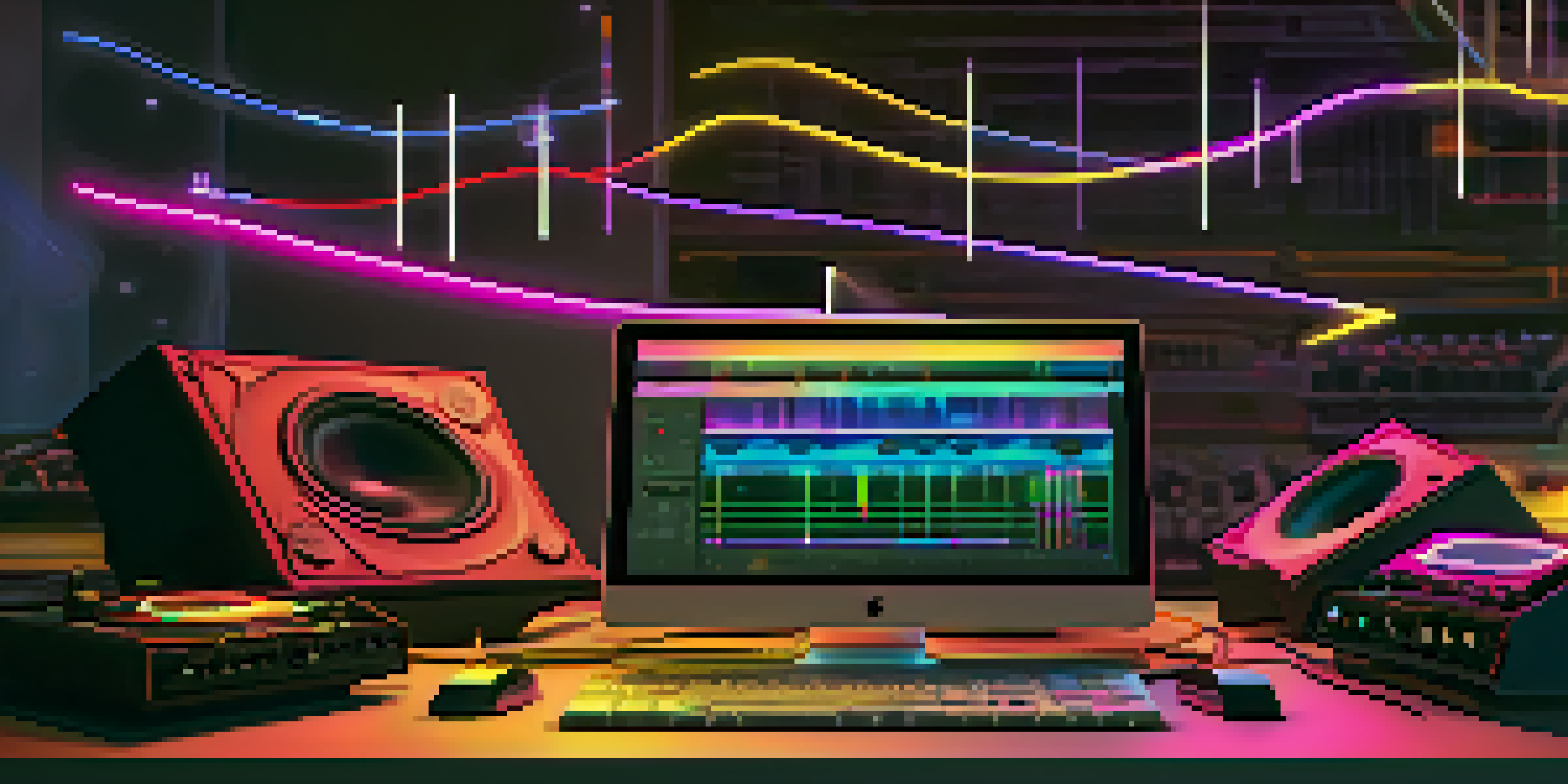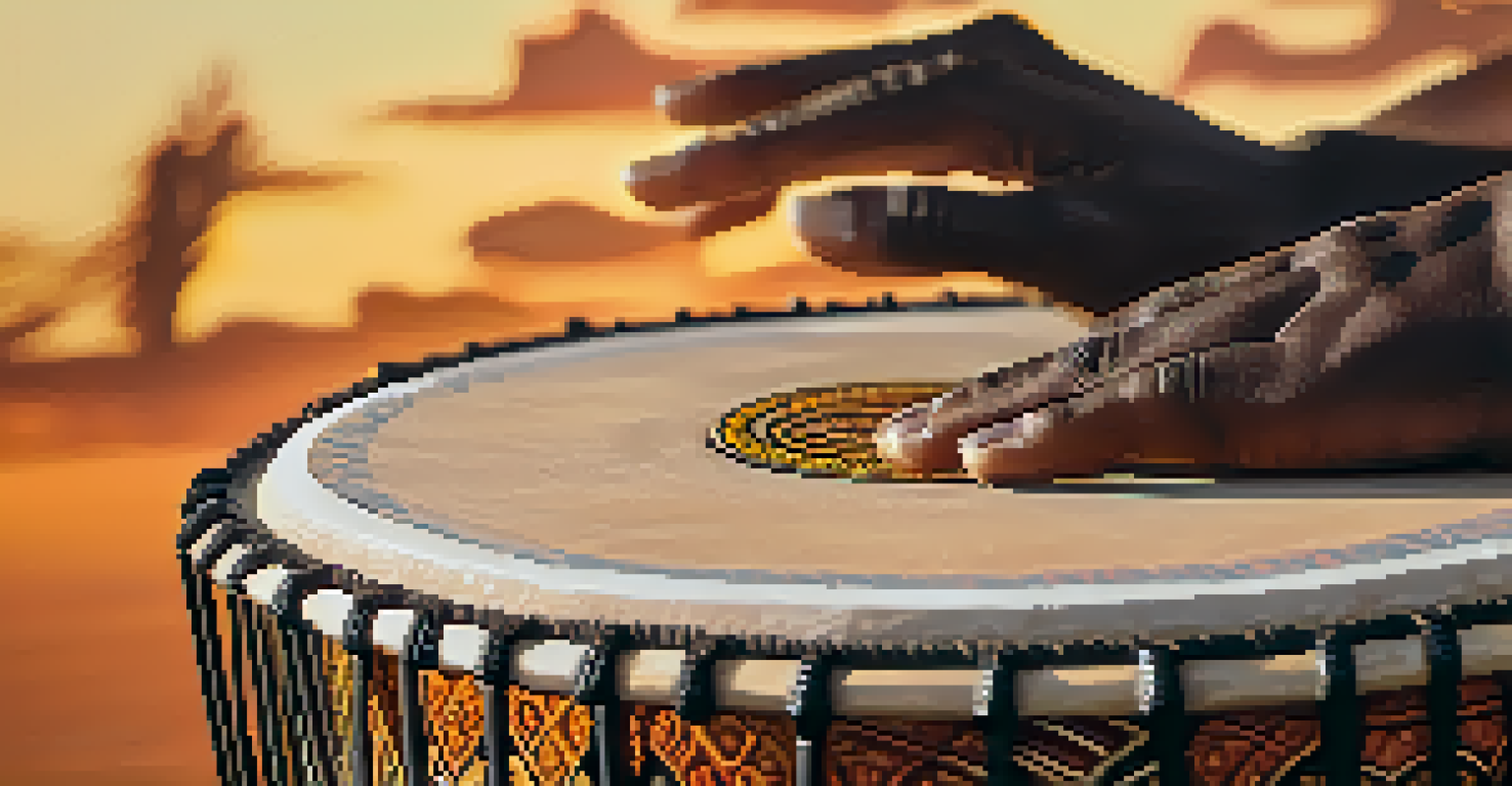Rhythmic Patterns: Crafting Unique Beats in Music Creation

Understanding the Basics of Rhythmic Patterns in Music
Rhythmic patterns form the backbone of any musical piece, providing structure and flow. They set the pace, guiding musicians on when to play notes and how to express emotions. Think of rhythms as the heartbeat of a song, pulsing steadily to engage listeners.
Music is the shorthand of emotion.
To grasp rhythmic patterns, it's essential to familiarize yourself with terms like tempo, meter, and beat. Tempo refers to the speed of the music, meter is the recurring pattern of beats, and the beat is the basic unit of time in music. Understanding these concepts allows you to manipulate rhythms effectively.
By experimenting with different rhythmic patterns, you can create unique beats that resonate with your audience. Whether you're a beginner or an experienced musician, recognizing the significance of these patterns will enhance your music creation process.
Exploring Different Types of Rhythmic Patterns
There are countless rhythmic patterns, each offering a different feel and vibe to your music. For instance, a simple four-on-the-floor beat is prevalent in dance music, creating an upbeat and driving sound. On the other hand, syncopated rhythms add complexity and surprise, making a track more engaging.

You can also explore polyrhythms, where two or more contrasting rhythms play simultaneously. This technique adds depth and richness to your music, often found in jazz and world music. Incorporating such varied patterns can elevate your composition, making it stand out.
Rhythmic Patterns Define Music's Pulse
Rhythmic patterns are essential for structuring music, guiding musicians on expression and timing.
The beauty of rhythmic patterns lies in their versatility. By mixing and matching different types, you can craft beats that reflect your unique style and musical voice, allowing for endless creative possibilities.
The Role of Technology in Crafting Rhythmic Patterns
In today’s digital age, technology plays a pivotal role in music creation, especially in crafting rhythmic patterns. Digital Audio Workstations (DAWs) offer an array of tools for musicians to easily create, edit, and manipulate beats. This accessibility has democratized music production, allowing anyone with a computer to explore their creativity.
Rhythm is the pulse of music, and without rhythm, there is no music.
Software like Ableton Live or FL Studio enables you to experiment with different rhythmic patterns effortlessly. You can use drum machines, loop libraries, and MIDI controllers to craft intricate beats that might be challenging to create manually. This technology not only simplifies the process but also inspires new ideas.
Moreover, online resources and tutorials can help you learn various techniques for crafting unique rhythms. With the right tools and guidance, you can harness technology to enhance your rhythmic creativity and produce captivating music.
Incorporating Cultural Influences into Rhythmic Patterns
Music is a universal language, and incorporating cultural influences can add depth to your rhythmic patterns. Different cultures have unique rhythms that tell stories and evoke emotions. For example, African drumming often utilizes complex polyrhythms, while Latin music features syncopated patterns that create a lively atmosphere.
By studying various musical traditions, you can integrate diverse rhythms into your compositions. This not only enriches your music but also connects you to a broader audience. Think of it as blending spices in a dish—the right combination can create a flavorful experience.
Cultural Rhythms Enrich Composition
Incorporating diverse cultural rhythms adds depth and emotional resonance to your musical creations.
Experimenting with cultural rhythms encourages exploration and creativity, helping you develop a distinctive sound. As you learn and incorporate these influences, you’ll find yourself crafting beats that resonate on multiple levels, making your music more relatable and impactful.
Using Rhythmic Patterns for Emotional Expression
Rhythmic patterns are powerful tools for conveying emotions in music. A slow, steady rhythm can evoke calmness or sadness, while a fast, upbeat rhythm can generate excitement and joy. Understanding how to manipulate rhythm allows you to express a wide range of feelings in your compositions.
For instance, consider how a waltz’s 3/4 time signature creates a sense of elegance and nostalgia. Conversely, a driving rock beat can elicit adrenaline and energy. By carefully selecting and arranging your rhythmic patterns, you can guide the emotional response of your listeners.
As you craft your music, think about the emotions you want to convey and choose rhythms that align with those feelings. This intentionality in your rhythmic choices will enhance the connection between your music and your audience, creating a more profound listening experience.
Experimenting with Unconventional Rhythmic Patterns
Stepping outside traditional rhythmic patterns can lead to innovative and exciting music creation. Don't hesitate to break the rules—try using irregular time signatures or unexpected accents. This approach can surprise your listeners and keep them engaged.
For example, experimenting with 5/4 or 7/8 time signatures can give your music a unique flair, often found in progressive rock or some jazz compositions. These unconventional rhythms challenge the listener’s expectations, creating a dynamic listening experience.
Experimentation Sparks Creativity
Stepping outside traditional rhythms and experimenting with unconventional patterns can lead to innovative music.
Additionally, incorporating silence and pauses can be just as impactful as sound. Allowing moments of quiet in your rhythmic patterns creates tension and anticipation, making the subsequent notes even more powerful. Embrace experimentation, and you'll discover fresh ways to express your creativity.
Final Thoughts: The Art of Crafting Unique Rhythmic Patterns
Crafting unique rhythmic patterns is an art form that combines creativity with technical skills. As you explore different rhythms, remember that there’s no right or wrong way to create music—only your personal expression. Trust your instincts and let your creativity flow.
Practice is essential in mastering rhythmic patterns. Spend time experimenting with various techniques, tools, and influences to discover what resonates with you. The more you practice, the more confident you’ll become in creating rhythms that reflect your unique voice.

Ultimately, rhythmic patterns are not just about keeping time—they are about making a connection with your audience. Whether you’re a seasoned musician or just starting, embracing the art of rhythm will enrich your music and enhance your creative journey.